Earth’s oldest living ecosystems and home to both people and wildlife, rainforests are all that and a bag of chips. They exist on every continent but Antarctica.
But how much do you really know about rainforests? Hopefully, after reading this article, you can say, “A lot!” Rainforests cover only 6% of the Earth’s surface yet provide lifesaving nutrients and medicines to our entire world.
Somehow its definition, “a luxuriant, dense forest rich in biodiversity, found typically in tropical areas with consistently heavy rainfall,” doesn’t do it justice.
So we’re going to try to do just that. Because rainforest facts need to be heard. They hold an abundance of answers yet are still, to this day, quite a mystery. Let’s get into the area that holds the health of our planet in its hand. Let’s go into “the jewels of the earth” – Rainforests.
Top 10 Most Interesting Facts About Rainforests
- Six percent of the earth is covered by rainforests.
- Rainforests receive 250 cm of rain annually, sometimes even 450 cm.
- Amazon rainforest is the world’s largest rainforest.
- Almost 47 million people, with 2 million indigenous people, live in the Amazon.
- Rainforests harbor the most diverse plant and animal species of any terrestrial ecosystem.
- Almost 70% of plants potent against cancer are found in rainforests.
- Rainforests are an important armor to fight against climate change.
- Annually, rainforests are disappearing at a rate of 10 million hectares.
- Demolition of tropical rainforests has shrunk from 11 million hectares per year to 7.8 million hectares per year.
- Innovative concepts are being suggested to safeguard rainforests.
Rainforests: Nature’s Hidden Wonders
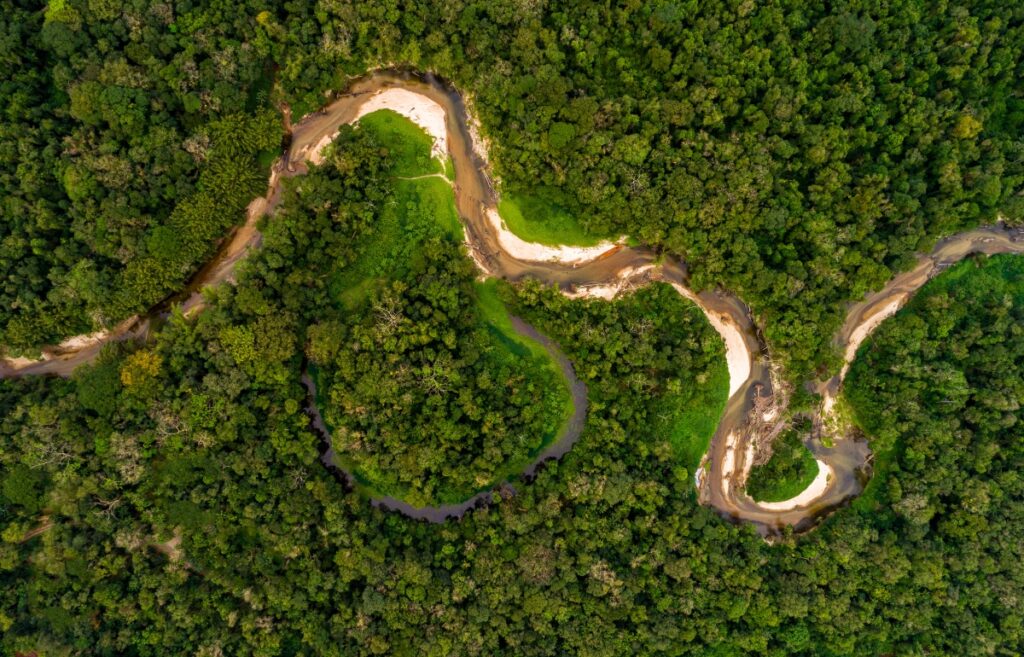
There are two types of rainforests (who knew!). One is tropical, while the other is temperate. You can find the tropical types closer to the Equator, where it’s warm, and the temperate rainforests are cooler coastal areas north and south of it.
Are rainforests jungles? Are jungles rainforests? The answer isn’t cut and dry.
Rainforests have lush canopies and taller trees than jungles. Canopies are dense layers of vegetation about 20 feet deep that form a canopy-like “roof.” Jungles have dense vegetation on the ground since it has more light streaming in from the sky. Rainforests are almost free of vegetation on their floor since there is very little light. They’re quite similar but different.
And so begins the mystery…
Just how does the world’s original forest cover help the fight against climate change while being forced to aid in the speed of it?
According to NASA, “Climate change is a long-term change in the average weather patterns that have come to define Earth’s local, regional, and global climates.” This is due to global warming, an event caused by human activity, which traps CO2 in the earth’s atmosphere. Although we need this gas to sustain life, too much of it is dangerous.
Trees absorb carbon and store it in the soil and in wood and plant matter. You could call them our CO2 keepers. Unfortunately, deforestation is obliterating our forests, so trees that are felled release the CO2 back into the atmosphere where it doesn’t belong.
So, on the one hand, trees store muchly needed CO2, and on the other, they release it when they’re cut down, which is to our detriment since it exacerbates climate change. Man has made rainforests an unwilling participant in global warming.
Where Are Rainforests Located?
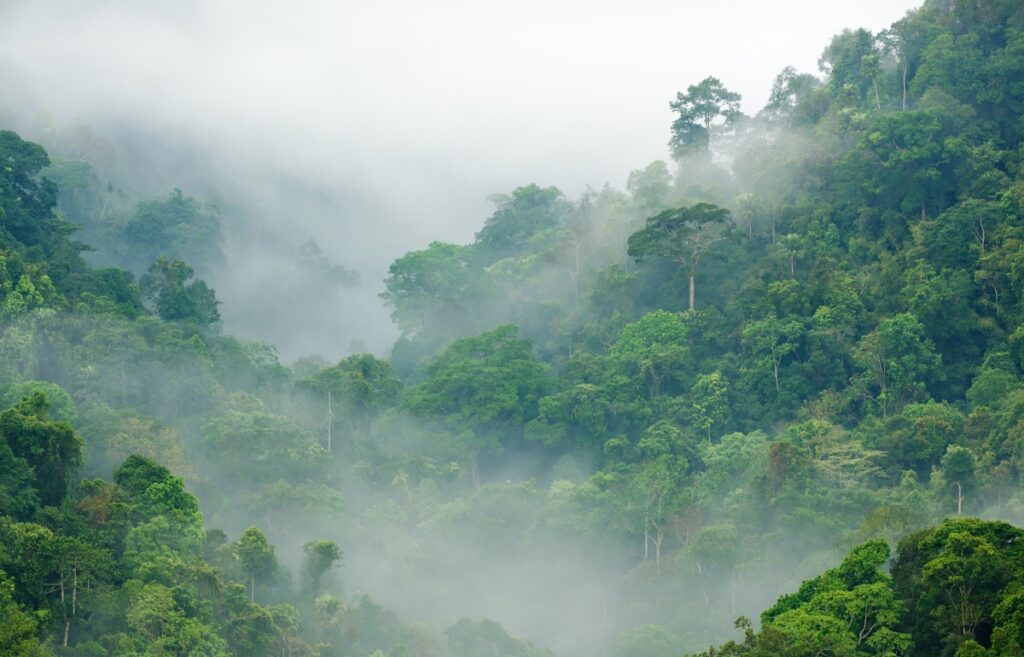
- Central and South America
- Western India
- New Guinea
- Australia
- Western and Central Africa
- Southeast Asia
Rainforest Facts
Get ready to explore the wonders of rainforests through fascinating facts! From incredible biodiversity to ecological marvels, join us on a journey into these lush and vital ecosystems:
Six Percent of the Earth Is Covered by Rainforests (National Geographic)
Since they once covered over 14% of the earth’s land, you can see the urgent condition our world’s forests are in. In 2020, 25.8 million hectares (1 hectare is equal to 2.47 acres) of forests were lost due to deforestation.
Rainforests Produce 20% of Oxygen, Store CO2, Curbing Greenhouse Emissions (National Geographic)
Add to that enormous amounts of absorbed solar radiation, and you have rainforests that can regulate temperatures around the planet. Our trees are working as hard as they can to stabilize climate change by storing as much carbon as possible. In a world with no deforestation, this would keep things running smoothly.
Types of Rainforests Include Tropical and Temperate Rainforests. (NASA)
Tropical rainforests consist of thick, woody vines in the canopy (think Tarzan). The biome, an area classified by the species that live in its location, is hot and moist. It rains all year long. (source)
Temperate Rainforests Hold the Highest Concentration of Above-ground Carbon Globally. (IOP Science)
That equals up to 1,500 tonnes (2,204.6 lbs.) per hectare. Examples of temperate rainforests would be those in Scandinavia and the Pacific Northwest. (source)
Rainforests Receive 250 cm of Rain Annually, Sometimes Even 450 cm. (Bio libre texts)
This is equivalent to 79–394 inches per year. There are wet months when precipitation can be 11”-12” and dry months with 3.5”. But even in the driest month, the amount exceeds the annual rainfall of deserts.
In Rainforests, Around 2% of the Sunlight Reaches the Ground. (Cotf.edu)
Due to the massive treetops and canopy that practically stop the sunlight, there is little vegetation on the rainforest floor. This condition is despite the 12 hours of sunlight the biome receives daily.
High Percentage of Life in the Rainforest Resides on Trees. (Rainforest Mongabay)
Monkeys, snakes, birds, and the like use the trees like a highway. An estimated 50%-90% of rainforest life lives there.
In Dominica’s Caribbean Rainforest, a Lake Simmers at about 88°C (190°F). (National Geographic Kids)
It’s called Boiling Lake, and it’s Dominica’s most famous one. The locals there call the rain “liquid sunshine.” (source)
Rainforest, an Important Armor to Fight Against Climate Change (World Economic Forum)
Trees are doing the heavy lifting as they store carbon, so we must fight just as hard. The UN says governments and corporations need to do more. Mother Nature also gave tropical forests the power to control our earth’s climate. That’s right… they’re climate stabilizers. Worldwide. (source)
Annually, Rainforests Are Disappearing at a Rate of 10 Million Hectares. (FAO)
Or over 24 million acres per year. Each minute, 2400 trees are leveled/razed. (source)
Human Activities Are the Major Contributor to Rainforests’ Destruction. (Rainforest concerns)
These activities are:
- Industrial agriculture (Deforestation, cattle ranching)
- Logging
- Mining
- Expansion and infrastructure
- Climate change
Deforestation Adds Nearly 5 Billion Metric Tons of Carbon Dioxide Annually. (World Resource Institute)
The World Resources Institute estimates that in the coming decades, global deforestation will add 3.5 to 4.2 billion metric tons of greenhouse gasses to the atmosphere. That’s about 10% of recent carbon dioxide emissions annually. (source)
Innovative Concepts Are Being Suggested to Safeguard Rainforests. (Conserve Energy Future)
- The venture capital group Single.Earth has developed a system where owners are rewarded for preserving their ecosystems. This way, there’s no need to sell to potential nefarious persons in order to turn a profit. “Their online platform allows forests, wetlands, and other natural areas to generate income by being left alone…” reports springwise.com.
- Alam Sehat Lestari (ASRI) is a non-profit that provides healthcare discounts to villagers who do NOT log. ASRI gives villages that stop logging up to 70 percent off of their medical bills. Due to this ingenuity, human and natural health have improved, logging has been reduced, and infant deaths have fallen by 60 percent. (source)
Bravo to these companies and many more who use their businesses to combat climate change.
Amazon Rainforest Facts
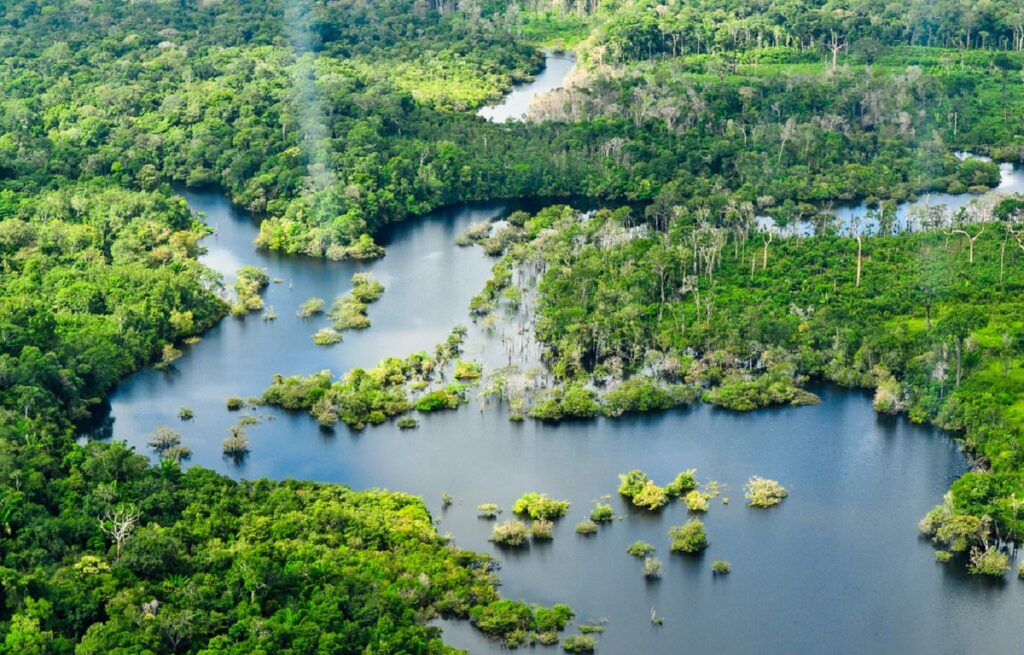
Step into the heart of the Amazon rainforest as we unveil captivating facts about this unparalleled ecosystem, spanning nations and harboring an astonishing array of life:
Amazon Rainforest Is the World’s Largest Rainforest (WWF)
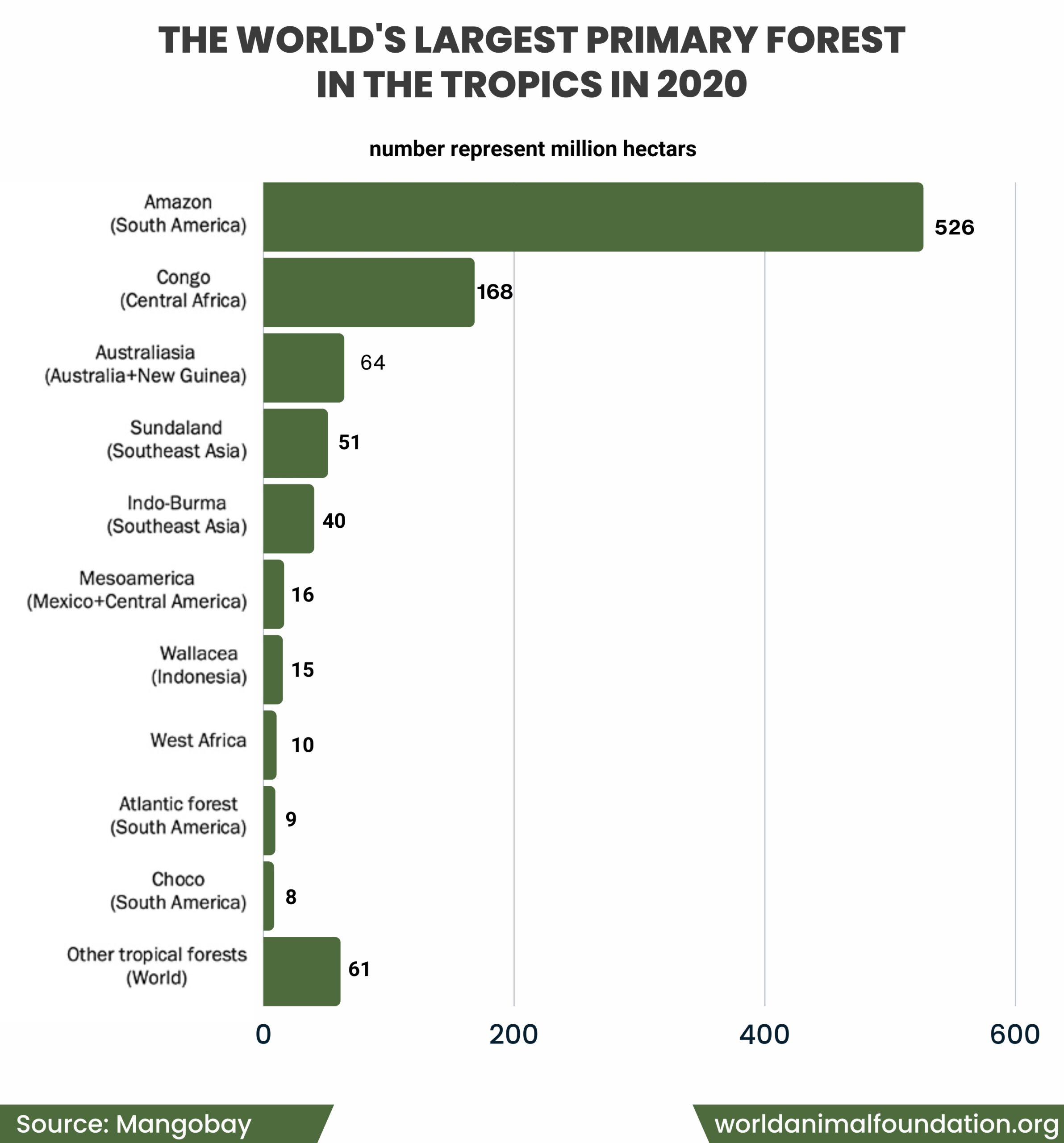
The second largest rainforest, the Congo, is less than half the size of the Amazon. Over half of all tropical forest area in the world is in the Amazon. (source)
Amazon Rainforest Is Home to More than 2.5 Million Different Insect Species. (Nature and Culture International)
From its most common insect, ants, to the amazingly strong rhinoceros beetle, these are among the insects that are known. Many have not been discovered yet. (source)
More than Half of the Amazon Is Located in Brazil. (WWF)
Covering an expansive 2.6 million square miles across nine countries, the Amazon Basin holds a remarkable distinction: approximately 60 percent of this biodiverse marvel resides within the borders of Brazil.
Almost 17% of the Amazon Rainforests Have Been Destroyed over the past 5 Decades. (WWF)
This is mostly due to land area conversion or leveling forests for cattle to graze before they’re slaughtered. Everyone is not aware of deforestation, but the process is a dangerously high threat to our tropical forests.
Almost 47 Million People, with 2 Million Indigenous People, Live in the Amazon. (WWF)
More than 400 unique indigenous groups live there and speak around 300 different languages. Guarani and Ticuna are the largest indigenous tribes in Brazil.
Plants in the Rainforest
Venturing into the rainforest reveals a world where plants reign supreme, from towering trees reaching for the canopy to delicate ferns carpeting the forest floor:
Rainforests Harbor the Most Diverse Plant and Animal Species of Any Terrestrial Ecosystem. (ESA Journals)
A terrestrial ecosystem is a land-based community of organisms and the interactions of components within it. Some examples would be deserts, tropical forests, tundra, and grasslands.
A 10-sq-kilometer or 4-sq-miles of rainforest can be home to:
- 1,500 flowering plants
- 400 bird species
- 750 tree species (source)
A Few Pine Trees in Tasmania’s Temperate Rainforests Have a Lifespan of Around 2,000 Years. (One Earth)
Although planting trees is an excellent undertaking, it would take hundreds, even thousands of years, to regrow tropical forests to their original state after being burned down or leveled. (source)
Almost 70% of Plants Potent Against Cancer Are Found in Rainforests. (Science Direct)
This is reported by the US National Cancer Institute. Organism extracts from medicinal plants are used as medicine/drugs for ailments from headaches to malaria. (source)
80% of Australian Rainforest Flowers Are Exclusive to the Region. (One Tree Planted)
The idiot fruit or Idiospermum Australiense, is the world’s rarest flowering plant and exists in the Daintree rainforest. (source)
Most of the Products of Daily Usage Come from Rainforests. (WWF)
Things like moisturizer, shampoo, and cinnamon originate from the rainforests. Let’s hope it doesn’t take us losing these products to do something extreme to help these biomes. There’s more than just wood that comes from our world’s rainforests. (source)
Timber, Cocoa, Chocolate, Coffee, and Pineapple All Come from Rainforests. (WWF)
This should be an incentive for us to speak up against rainforest destruction since these are the favorite products of many. Well. I could do without the pineapple.
Tropical Rainforest Facts
Let’s uncover captivating facts about these lush rainforests, where vibrant biodiversity and dynamic ecosystems thrive under the canopy’s embrace:
Around 3% of the Planet is Covered by Tropical Rainforests (Study.com)
Tropical rainforests cover approximately 3% of our planet’s surface. Despite their relatively small footprint, tropical rainforests are home to over half of the world’s plant and animal species.
About 1.2 Billion Hectares of Vegetation Are Covered by Tropical Rainforests. (Earthdata)
These trees and vegetation are critical to Earth’s carbon cycle. Our planet gives us what’s necessary to live. We can’t continue to destroy it and expect it to keep on giving. (source)
Certain Tropical Rainforests Have Existed since the Time of Dinosaurs on Earth. (Smithsonian Magazine)
In fact, South American rainforests most likely multiplied during that time. These magnificent biomes are some of the oldest areas on Earth. (source)
The Average Temperature of Tropical Rainforests Is Between 70-85° F. (Conserve Energy Future)
This air temperature makes it the ideal spot for organisms of all types to thrive. Sort of like going on a trip to balmy San Francisco. (source)
In Tropical Rainforests, It Can Take Almost 10 Minutes for a Raindrop to Fall on the Ground. (National Geographic)
This gives you an idea of how dense tropical forests are. They’re not your average jungle.
Tropical Rainforests Regulate the Water Cycle. (Rainforest Concerns)
Rainforest destruction disturbs the water cycle of the entire world. Have you ever seen a champagne pyramid at a wedding? Just imagine the top glass being the rainforests. (source)
Demolition of Tropical Rainforests Has Shrunk from 11 Million Hectares per Year to 7.8 Million Hectares per Year. (FAO)
According to the Food and Agriculture Organization (FAO), deforestation in 2022 slowed by 30% compared to the previous ten years. That said, from 2000-2018, the highest level of deforestation happened in South America and Africa, with 68 million hectares and 49 million hectares, respectively. (source)
For Agricultural and Industrial Development, 40 Hectares of Rainforests Are Cleared per Minute. (Fraser Institute)
Why? The world wants meat is one of the top three reasons. Almost all the beef received by America’s fast-food restaurants can be traced to a rainforest’s destruction. From earth.org, “Beef is responsible for 41% of global deforestation.” (source)
More than 25% of the World’s Population Relies on Rainforests for Their Livelihood. (Rainforest Alliance)
We’re talking about almost 1.6 billion people. Indigenous communities thrive from forest resources. Trees are used to generate money and food by 1.2 billion folks. (source)
In 2021, Almost 3.75 Million Hectares of Tropical Rainforests Were Lost. (Rainforest Rescue)
Carbon emissions were 2.4 billion tonnes. It’s not sustainable. (source)
In Terms of Tropical Primary Forest Loss, Brazil was the Leading Country in 2021 (WRI)
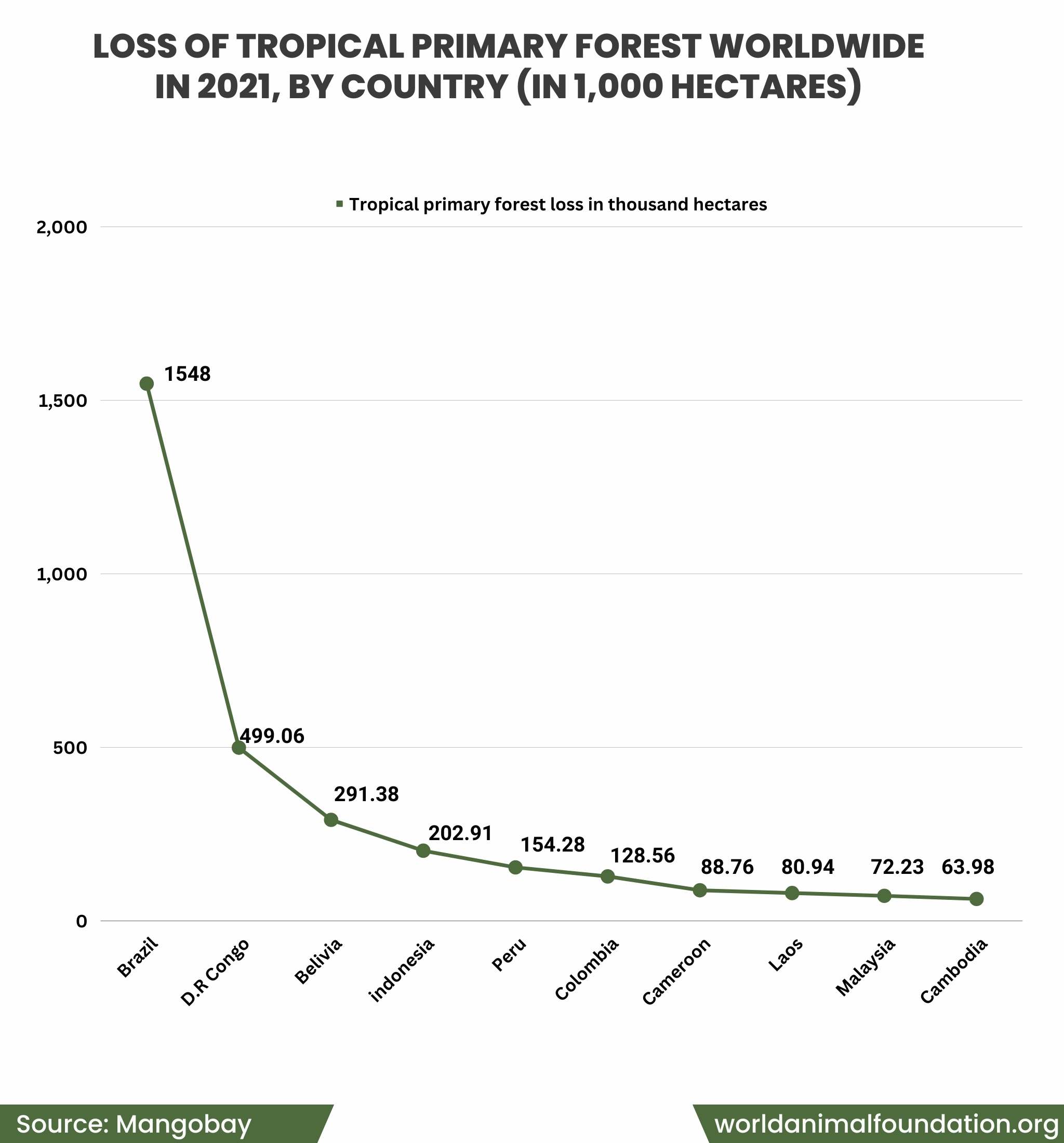
According to WRI data, Brazil led in tropical primary forest loss in 2021. This highlights the urgency to address deforestation in the Amazon and safeguard its vital role in biodiversity, climate, and indigenous communities.
Every Day, about 137 Plant and Animal Species Vanish from the World’s Tropical Rainforests. (Rainforest Action Network)
As an animal rescuer, staunch advocate, and vegetarian, this statistic crushes me. We’re exchanging the very existence of animals in order to have our own unnecessary desires. (source)
The Ongoing Depletion Is Projected to Result in a Loss of 5-10% of Tropical Rainforest Species per Decade. (National Geographic)
Large mammals, birds, insects, and reptiles are the bulk of wildlife in the temperate rainforest. Species do vary, depending on the region of the world and the tropical forests they’re in.
Rainforest Structure
The intricate and layered structure of rainforests creates a captivating tapestry of life, where every level teems with diverse flora and fauna.
Layers of the Rainforest
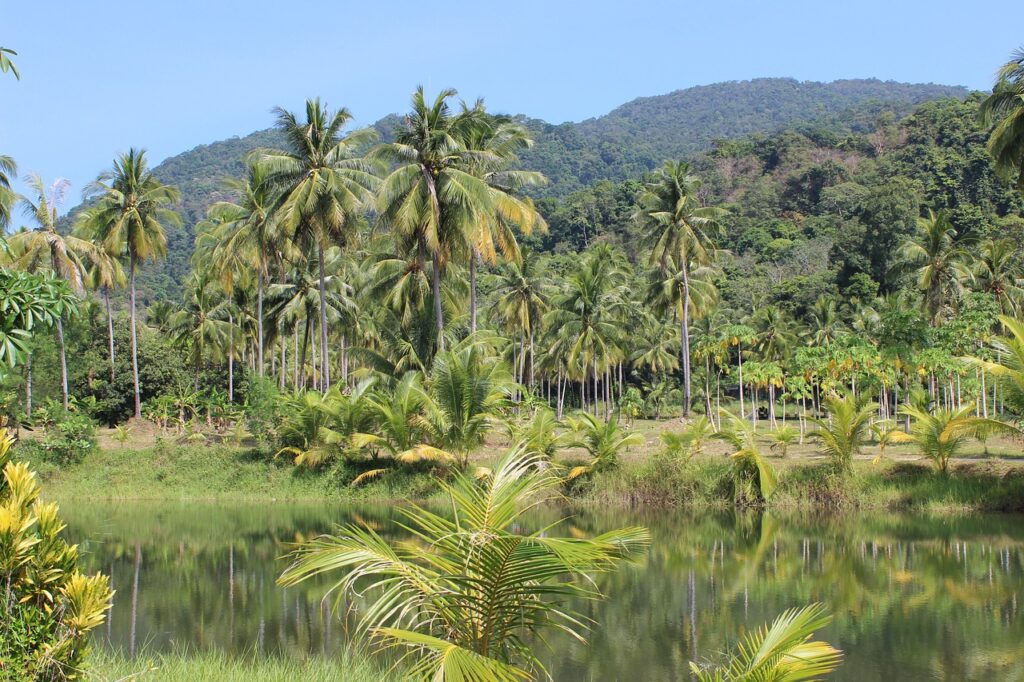
Delving into the rainforest’s layers unveils a vertical world of distinct habitats, from the vibrant canopy where sunlight dances to the shadowy forest floor bustling with unique life forms:
Emergent Layer
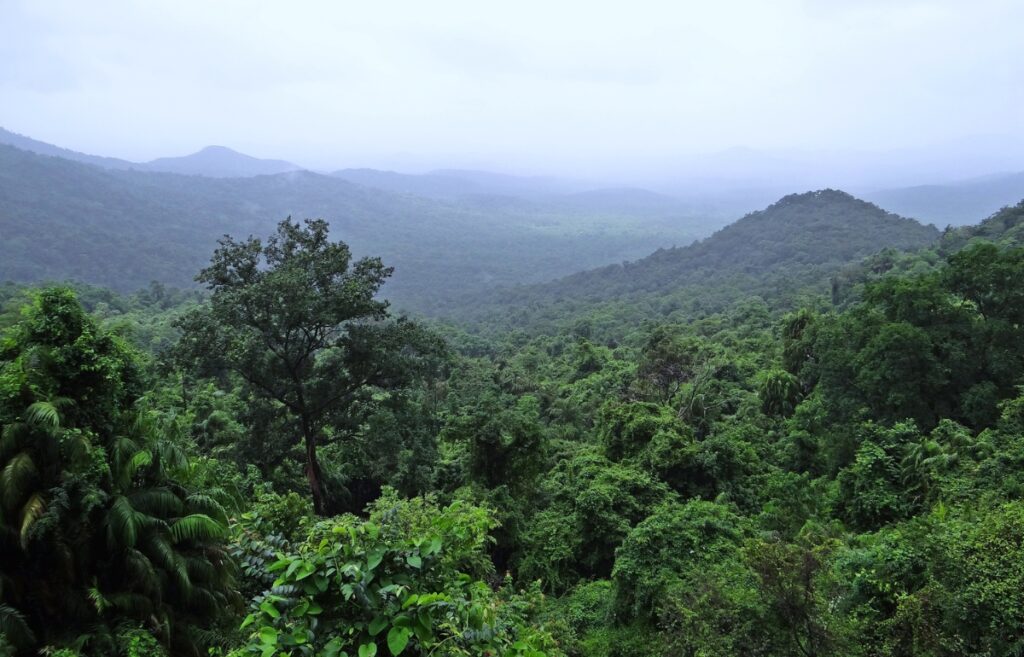
Topmost Layer of Rainforest Is the Emergent Layer. (National Geographic)
This layer receives bright sunlight and plenty of rain. Trees as tall as 200 ft. reach majestically skyward. Foliage is dense and largely consists of small waxy leaves that help trees retain water during dry seasons.
In the Emergent Layer, Trees Towering up to 60 Meters Define the Horizon. (Micro B life)
These mostly evergreen trees stretch above the canopy. Monkeys abound in the skyscrapers’ emergent layer. (source)
The Brazil Nut Tree of the Emergent Layer Can Survive up to 1,000 Years in Undisturbed Rainforests. (Rainforest Alliance)
The tree grows best in non-flooding areas and is often found in a group of 50 or more trees that are similar. These groupings are called “stands.” (source)
Birds, Bats, and Gliders Reside in the Emergent Layer. (National Geographic)
Smaller animals find a safe haven among branches that may be too light for larger predators. Insects in the emergent layer include moths, butterflies, bees, and wasps and grow much bigger than in any other place in the world. Add to that tarantulas, hummingbirds, and macaws.
The Emergent Layer of New Guinea’s Rainforests Is Inhabited by Pygmy Gliders. (Twinkl USA)
Also known as the pygmy flying possum and flying mouse, pygmy gliders are the world’s smallest gliding mammal. These cuties are endemic to Australia. They’re highly agile and can maneuver between the highest branches. (source)
Predators in the Emergent Layer
Raptors:
- White-tailed hawks
- Harpy eagles
Canopy Layer
Under the Emergent Layer Is a 20-foot-thick Canopy Layer of Dense Vegetation. (National Geographic)
Since the canopy blocks wind (rain and sunlight), seeds can’t be scattered by it. No problem. No problem…Trees encase their seeds inside the fruit that animals eat and scatter over the forest floor.
This Layer Has a Dark and Humid Environment. (National Geographic)
The lack of light and moist surroundings would make for a great sauna. It’s caused by the foliage being so tightly packed.
The Most Commonly Found Trees in the Canopy Layer Are Fig Trees. (Scotland’s Theme Park)
Fig trees have twisted wood that looks similar to branches but exists throughout the tree. This helps to make them undesirable to loggers, and they are often the only trees standing after a forest clearing. (source)
Abundant Food Makes the Canopy the Most Populated Rainforest Layer. (Science Struck)
The canopy is rich with seeds and fruits – some species’ smorgasbord. (source)
Thousands of Insect Species Can Be Found Here. (National Geographic)
In rainforests, bigger is better, so if you’re afraid of bugs, the canopy wouldn’t be your favorite spot.
Predators in Canopy Layer
- The puma/mountain lion
- Leopard cat
- Margay
- Ocelot
- Snakes
Understory Layer
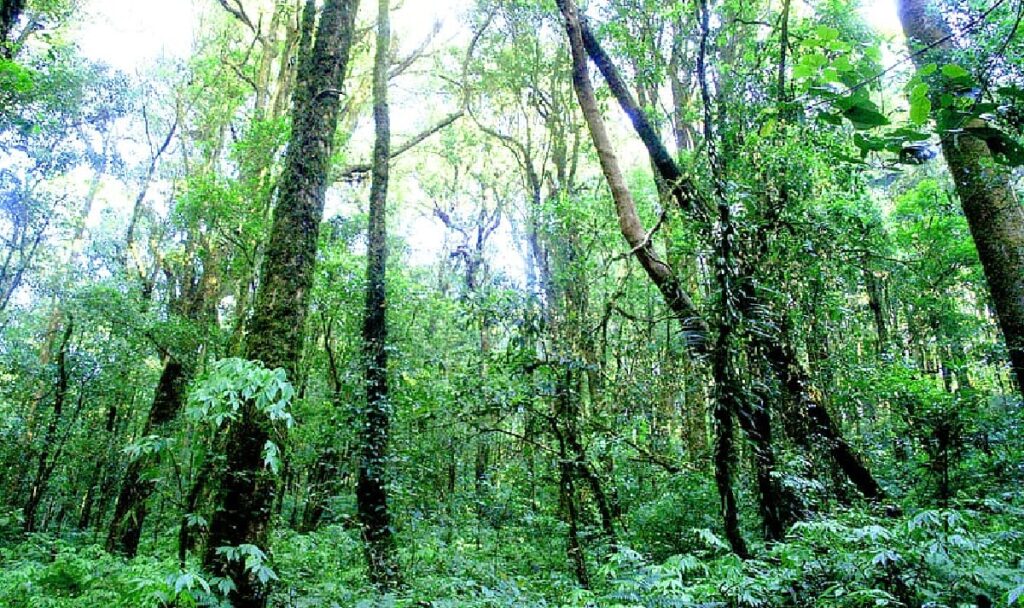
Below the Canopy Lies the Understory, Which Is Darker, Calmer, and More Humid. (CSUS)
The understory is calmer since there’s relatively no wind and not a lot of sound. It’s also cooler since direct sunlight doesn’t penetrate the layer. (source)
Palms and Philodendrons Inhabit This Layer. (National Geographic)
There are many types of plants on this layer that have huge plate-like leaves that are 12” across. Conversely, you’d never see leaves this size near the canopy.
Understory Plants, like the Heliconia, Often Have Large and Noticeable Flowers. (Science Direct)
Flowers on this layer have evolved and can appear pale so animals and insects can see them to transfer pollen in low light.
Edible Fruits and Seeds Are Common among Rainforest Understory Shrubs. (Twinkl USA)
Edible delights:
- Yucca roots and leaves
- Mushrooms
- Edible ferns
- Grapes.
- Vanilla
- Bananas
- Green plantains (source)
The Layer Is Home to a Number of Endangered Animal Species. (National Geographic)
Central Africa’s understories are home base to:
- Forest elephants
- Pythons
- Antelopes
- Gorillas.
Predators in Understory Layer
- Bats
- Snakes, including boa constrictors
Forest Floor Layer
The Forest Floor Layer Is the Darkest of All Layers. (National Geographic)
Very few plants grow along the floor. Even leaves quickly decay on this layer.
Termites, Slugs, Scorpions, Worms, and Fungi Thrive as Forest Floor Decomposers. (National Geographic)
They’re called decomposers since they break down decaying material into nutrients that the tree roots absorb.
Wild Pigs, Armadillos, and Anteaters Forage for Insects, Roots, and Tubers. (Rainforester)
Rodents hide from predators under tree roots, and leopards are keen hunters on the rainforest floor. (source)
Rainforests Feature Rivers That Form Unique Freshwater Habitats on the Forest Floor. (National Geographic)
The Nile crocodile hangs his hat in the Congo River located in Central Africa. It’s their second-longest river.
The Amazon River Is Home to Boto or the Pink River Dolphin. (WWF)
(Yes, they’re actually pink and live in freshwater.) The largest species of the alligator family in the Amazon ecosystem can be found in the Amazon basin and is called the Black Caiman. Its menu is turtles, birds, fish, and sometimes land-dwelling animals. Yikes! (source)
Predators of Forest Floor Layer
- The most abundant vertebrate predators of the forest floor are snakes and lizards – The constrictors, pythons, anacondas, cobras, mambas, etc. There are around 500 species of lizards, snakes, turtles, tortoises, and caiman in the Amazon Basin.
Rainforest Characteristics
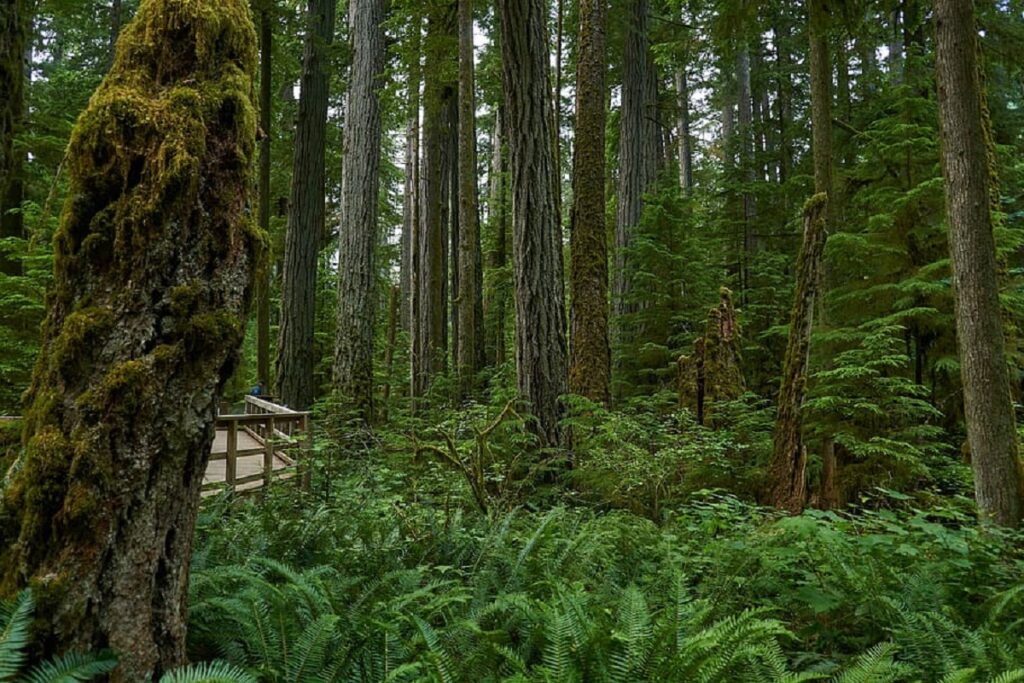
Rainforest Ecosystem
The environment is wet in tropical rainforests, and the humidity stays between 77%-88% year-round. It is a home in a biome of wildlife and plant species. Rainforest trees yield carbon and oxygen.
Rainforest Animals
Here are a few incredible species:
- Bengal Tiger
- Chimpanzee
- Gorilla
- Manatee
- Golden Lion Tamarin Monkey
- Poison Dart Frog
- Orangutan
- Jaguar
- Leopard
- Three-toed Sloth
- Hyacinth Macaw
- Toucan
Tropical Rainforest Biome
Rainforests are one of seven biomes on the planet. The others are:
- Grassland
- Coniferous Forest
- Temperate Deciduous Forest
- Desert
- Tundra
- Shrubland
What Measures Can Stop Rainforest Degradation
SOLUTION: Become vegan or vegetarian.
WHY: Most deforestation (or mass razing of trees/forests) is due to the enormous demand for all kinds of meat. Since livestock that are slaughtered need to be fed to be able to produce meat, agricultural companies are killing our rainforests so they can mass-produce products. If you’re unsure, try Meatless Monday.
SOLUTION: Educate yourself and others on deforestation and the rainforest crisis.
WHY: When we’re aware of the facts, we can then move forward and take action.
SOLUTION: Reduce your carbon footprint by not traveling via plane, and also recycle, reuse, and repair.
WHY: Since deforestation has sent us hurdling into the predicament we’re in, anything we can do to combat climate change is a win for us.
Visit rainforestfoundation.org to learn much more about actions you can take.
FAQs
What Percentage of the World Do Jungles Cover?
Forests cover around 31% of our total land area. In 2020, there were 4.06 billion hectares of worldwide forest area. In 1990, the same forest area measured 4.24. billion.
Rainforests Cover Which Percentage of the Earth?
Rainforests cover 6% of the earth’s land surface.
How Many Rainforests Are There in the World?
Experts disagree on a specific number, but there are at least 20.
What Does a Rainforest Look Like?
The tropical rainforest is a rainy, hot, moist biome. It is known for its dense levels of vegetation that form three different layers before reaching the forest floor. The top layer, or emergent layer, contains giant trees that grow to heights of 250 ft. or more. Three other distinct layers lie beneath the top layer.
Where Are Tropical Rainforests Located?
Tropical rainforests are located between the latitudes of 23.5°N and 23.5°S — the tropics. They are found in tropical countries such as:
- Central and South America
- Western and Central Africa
- Western India
- Southeast Asia
- New Guinea (the island)
- Australia.
Explain Why Rainforests Are Important to Western Medicine.
Around 120 prescription drugs plus ⅔ of all medicines that fight cancer sold worldwide are directly derived from rainforest plants. There are medicines to treat:
- Malaria
- Heart disease
- Bronchitis
- Hypertension
- Diabetes
- Arthritis
- Glaucoma
And more.
What Animals Live in the Rainforest?
- Bengal Tiger
- Chimpanzee
- Gorilla
- Manatee
- Golden Lion Tamarin Monkey
- Poison Dart Frog
- Orangutan
- Jaguar
- Leopard
- Three-toed Sloth
- Hyacinth Macaw
- Toucan
Which Country Is the Amazon Rainforest In?
Almost 60% of the Amazon rainforest is in Brazil. The remainder is in the following countries:
- Bolivia
- Colombia
- Ecuador
- Guyana
- Peru
- Suriname
- Venezuela
- French Guiana (territory of France)
Conclusion
So where do we go from here? We recognize that each one of us has the power to take positive action to save the rainforests. We look at where our food is coming from so our buying decisions will be aligned with our values. We buy a few more oranges and a few less bananas.
Rainforests are one of the most spectacular places on our planet. But without care and concern, they will go away – trees taller than skyscrapers, gorillas that groom their young, the sloth’s cheeky grin, indigenous communities…Gone.
We could let a cure for cancer slip through our hands.
But I don’t believe in a world with no hope for our rainforests. So I’m going to believe in a world where passionate people come together to save them. I’m going to believe that good people can be underdogs and still win. I’m going to believe in you and me.


